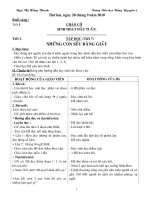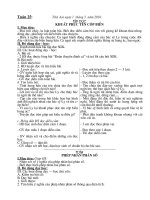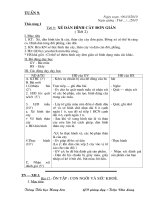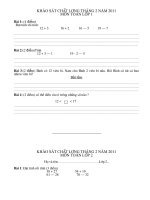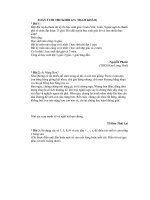- Trang chủ >>
- Mầm non - Tiểu học >>
- Lớp 5
5 4 2 feel, think, move (life science)
Bạn đang xem bản rút gọn của tài liệu. Xem và tải ngay bản đầy đủ của tài liệu tại đây (4.4 MB, 13 trang )
Suggested levels for Guided Reading, DRA,™
Lexile,® and Reading Recovery™ are provided
in the Pearson Scott Foresman Leveling Guide.
Genre
Expository
nonfiction
Comprehension
Skills and Strategy
• Generalize
• Compare and
Contrast
• Predict
Life Science
Feel,
Text Features
• Heads
• Sidebar
• Chart
Think,,
Think
Move
Scott Foresman Reading Street 5.4.2
ISBN 0-328-13552-6
ì<(sk$m)=bdf cd< +^-Ä-U-Ä-U
by Jana Martin
Reader Response
1. In general, how do growth spurts differ between
males and females?
2. Imagine that someone kicks you a soccer ball while
you’re out on the playing field. Using what you have
learned from this book, predict what happens next.
Use a chart like the one below to show how the brain
processes the information.
1. Lobe used:
2. Lobe used:
3. Lobe used:
Feel,
Think,,
Think
Move
by Jana Martin
3. Read the last paragraph on page 13 of this book.
What do you think the word cardiac means? What
other word is it related to? Use a dictionary.
4. How might the work a physical therapist does with
an athlete be different from the work he or she does
with an older patient?
Editorial Offices: Glenview, Illinois • Parsippany, New Jersey • New York, New York
Sales Offices: Needham, Massachusetts • Duluth, Georgia • Glenview, Illinois
Coppell, Texas • Ontario, California • Mesa, Arizona
A Remarkable System
Do you ever wonder what’s going on inside your
body when you hit a baseball or kick a soccer ball?
Your brain is telling the rest of your body what to
do. But without the muscles and bones in your body,
you wouldn’t be able to do either activity or even
stand upright. Your muscles and bones make up
an amazing system known as the musculoskeletal
system. Working together, muscles and bones enable
the human body to move.
Every effort has been made to secure permission and provide appropriate credit for
photographic material. The publisher deeply regrets any omission and pledges to
correct errors called to its attention in subsequent editions.
Unless otherwise acknowledged, all photographs are the property of Scott Foresman,
a division of Pearson Education.
Photo locators denoted as follows: Top (T), Center (C), Bottom (B), Left (L), Right (R),
Background (Bkgd)
Cover: ©Randy Wells/Corbis; 1 ©/DK Images; 3 ©Warren Morgan/Corbis; 5 ©/DK
Images; 6 (T) ©TRBfoto/Getty Images, (BL) ©3DClinic/Getty Images, (BR) ©3DClinic/
Getty Images; 7 (BL) ©3DClinic/Getty Images, (BR) ©3DClinic/Getty Images; 8 ©RoyaltyFree/Corbis; 11 ©Randy Wells/Corbis; 12 (L) ©Scott Bodel/Getty Images, (R) ©Scott
Bodel/Getty Images; 13 (R) ©Scott Bodell/Getty Images; 17 ©Ronnie Kaufman/Corbis;
18 ©Royalty-Free/Corbis; 19 (TL) ©LWA-Dann Tardif/Corbis, (C) Robert Landau/Corbis,
(R) ©Paul J. Sutton/Duomo/Corbis; 20 ©3DClinic/Getty Images
ISBN: 0-328-13552-6
Copyright © Pearson Education, Inc.
All Rights Reserved. Printed in the United States of America. This publication is
protected by Copyright, and permission should be obtained from the publisher
prior to any prohibited reproduction, storage in a retrieval system, or transmission
in any form by any means, electronic, mechanical, photocopying, recording, or
likewise. For information regarding permission(s), write to: Permissions Department,
Scott Foresman, 1900 East Lake Avenue, Glenview, Illinois 60025.
2 3 4 5 6 7 8 9 10 V0G1 14 13 12 11 10 09 08 07 06 05
3
The musculoskeletal system enables you to
zip up your coat, open the door, and go outside
to play. But how does your brain and the
musculoskeletal system communicate? In fact,
they are always communicating—even when
you’re asleep. Just about everything you do
today, tomorrow, and every day is a result
of communication between your brain and
your muscles and bones.
The Brain
Let’s start with your brain, which is housed
inside your skull. Your skull is made of hard
bone that protects the brain from injury. The
brain is where your thoughts and emotions
originate and where you make decisions. But
there’s a lot more going on than you might
think.
The brain is a relatively small organ of the
human body when you consider all that it
does. On average, the human brain weighs
three pounds. If a woman weighs 150 pounds,
the brain makes up only two percent of her
total body weight. The brain doesn’t look very
imposing either. It looks like a large, pinkishgray, mushy walnut. But the brain is the leader
of the rest of the body—the captain, so to
speak. The rest of your body would be the
obeying troops.
Everything in your body works together.
Every organ and body part is a member of a
system. The brain is no exception. It’s part of
the nervous system.
4
The nervous system includes the brain, the spinal
cord, and the nerves. The spinal cord follows your
spine, or backbone. The spinal cord is
like a main communications cable or
a two-way information highway. It
sends messages from the brain to
the rest of your body, and it sends
signals from the rest of your body
to your brain. Thirty-one pairs of
spinal nerves extend from the
sides of the spinal cord and
branch out into smaller and
smaller bunches of nerves,
reaching every part of your
body.
How do the different
parts of your body
communicate? Through
neurons! Neurons are
nerve cells that transmit
signals around your body
at up to 200 miles an hour.
There are neurons in your
brain, speeding around.
When a neuron “fires,” it sparks
a reaction in your brain, which
then sends signals to other
neurons. This sends a message
to certain muscles in your body
to contract. When your muscles
contract, your body moves.
5
Let’s take a closer look at your brain. It’s divided
down the center into two halves, called the cerebral
hemispheres.
Each half is divided into four parts, called lobes:
• frontal lobe: enables you to plan, speak, feel
emotions, solve problems, and move. Within
the frontal lobe is the motor cortex, which is
responsible for sending messages down your
spinal cord and to your muscles. This allows you to
move different parts of your body.
• parietal lobe: enables you to perceive pain and
different temperatures.
• occipital lobe: helps you to see through your eyes.
• temporal lobe: where your memory is stored. It
also enables you to understand what you hear.
left hemisphere
frontal lobe (movement, speech,
emotions); part of this is the motor
cortex (controls movement)
6
right hemisphere
parietal lobe (pain)
occipital lobe (sight)
temporal lobe
(memory, comprehension)
7
1. John’s eyes see the
ball approaching and
convert the image into
electrical impulses that
are sent to his brain.
Swing,
Batter,
Swing!!
Swing
2. Occipital lobe in
the brain gets a signal
from his eyes.
3.
The temporal lobe
remembers what he had
done in the past and
what his coach has told
him about the right way
to swing.
The Musculoskeletal System
Now let’s take a closer look at the musculoskeletal
system. It’s actually made up of two different
systems: the muscular system and the skeletal system,
or your muscles and your bones. These systems work
together to help you sit, stand, walk, run, and play
your favorite sport.
The Skeletal System
The skeletal system is the frame of the human
body. Can you visualize the scary skeleton you see
at Halloween? Each of us has a skeleton like that
inside. You just can’t see it because it is covered with
muscles, blood, and skin.
There are 206 bones of different shapes and sizes
in your body. Inside those bones is a softer center
that contains bone marrow, which produces red
blood cells and white blood cells. The skeletal system
also includes the connective tissues that fasten
those bones together. There are three main types of
connective tissue: cartilage, tendons, and ligaments.
Bones are made of collagen, a type of protein,
and calcium. Calcium is what keeps bones hard.
Connective tissue has collagen, but no calcium.
4. The frontal lobe processes
information about time and
distance, and then the motor
cortex sends a signal down
the spinal cord to different
muscles in the legs and arms.
8
5. His muscles
receive the signal
and swing!
9
It’s hard to imagine how eating a food could have a direct effect on your
body, but foods that have calcium are very important for your bones. If you
eat more calcium, you are increasing the amount of calcium in your bones.
That will make your bones stronger.
But how much calcium should you have? People between the ages of 9 and
18 should eat 1300 milligrams of calcium every day. And where do you get it?
In fact, many foods have calcium. But some foods have more than others.
Recommended Calcium Intakes
10
Food
Serving Size
Calcium
Yogurt
1 cup
450 mg
Fat-free milk
1 cup
352 mg
Calcium-fortified
orange juice
1 cup
333 mg
Macaroni and
cheese
1/2 cup
181 mg
Tofu
1/2 cup
130 mg
Soy beverage
1 cup
300 mg
Broccoli
1 cup
90 mg
Spinach, boiled
1 cup
244 mg
Almonds
1 ounce
(20–25 Almonds)
71 mg
Connectors
Connective tissue is softer than bone and keeps
the major bones in a person’s body together. One
type of connective tissue is cartilage.
Another type of connective tissue is the tendon.
Tendons, like tough cords connecting muscles to
bones, allow the muscles to pull on bones, causing
movement. Try wiggling your fingers as you look
at the top of your hand. Those lines you see on the
back of your hand are tendons. They attach your
fingers to your wrist and move when you move your
fingers.
The third type of connective tissue is the ligament,
which connects bones with other bones. Ligaments
are found in joints. A joint is where two major
bones come together, and it is usually a point of
movement. Knees, ankles, and elbows are examples
of joints.
These girls scramble
to get to the soccer
ball first. Their
knees are the most
important joints in
their bodies for this
sport.
11
smooth
muscle
cardiac muscle
skeletal muscle
Muscles
Do you ever wonder why sometimes your body
moves without you thinking about it moving? For
example, have you ever had the shivers or an eye
twitch? Or have you ever been to the doctor and felt
your leg jump after the doctor taps your knee with a
hammer?
The reason this happens is that you have different
types of muscles in your body. Some of them you
control voluntarily. Others move involuntarily.
You have three types of muscles:
• cardiac muscles
• skeletal muscles (also called voluntary muscles)
• smooth muscles
12
Skeletal muscles move bones and hold your
skeletal system upright. These muscles are generally
attached to two or more bones, either directly or
with tendons. Where they are attached to bones
at a joint, they work in opposing pairs. This means
one muscle contracts to bend a joint, and the other
contracts to straighten it. These are the muscles you
are usually aware that you are using.
Smooth muscles, on the other hand, are muscles
that are often working without your knowledge.
They move substances around, such as blood through
your blood vessels and food through your digestive
system.
The final type of muscles, cardiac muscles, make
up the wall of your heart. They help pump blood and
regulate your heartbeat rate. They are working all
the time, without any action on your part.
13
There are more than 600 muscles in the human
body. They make up, on average, half of a person’s
body weight. Each muscle has its own name.
• Muscles that bend are called flexors.
• Muscles that straighten are called extensors.
• Muscles that move a limb to the side, away from
the body, are abductors.
• Muscles that move a limb closer to the body are
called adductors.
It’s probably a surprise to you, but your face has
numerous muscles. They are working nearly all the
time. You use them every time you smile and every
time you frown. Unlike other muscles, facial muscles
do not attach directly to bone. Instead, they attach
under skin.
There’s another muscle group that you probably
don’t think about very often. You can’t tone it by
going to the gym. In fact you can’t really exercise
it at all. That muscle is your tongue! The tongue is
actually made up of a group of muscles that work
together to allow you to talk and chew food.
Motor Skills
What are motor skills? They have to do with a
person’s ability to control his or her muscles. Motor
skills improve naturally as we grow. They can also be
improved by practice.
When a baby is born, he has little control over his
muscles. But, as he grows, he gains more and more
ability to move—called motor skills. As his motor
skills develop, he learns to crawl, then stand, then
walk, and then run.
14
How We Grow
Before puberty, boys and girls have a very similar
shape. But during their teenage years, they go
through what is called a growth spurt. They both
change shape noticeably. Usually, for boys, this can
mean growing taller by as much as 3.5 inches (9 cm)
a year. Usually, for girls, this can mean growing at a
rate of 3.15 inches (8 cm) a year.
We don’t grow all at once. The hands and feet
grow first. Then the arms and legs grow. The spine,
or backbone, is the last part to grow. As a result of
these rapid changes, many teenagers need to buy
new shoes and clothes often. This also explains why
some teenagers may feel less coordinated. Their
bodies are growing so fast, and their brains have a
hard time adjusting.
Girls usually finish this growth spurt before boys
do. By the age of fourteen, most girls have reached
their adult height. Boys, on the other hand, won’t
finish growing until around age twenty. Because
they have more years to grow, adult men are, on
average, 5.12 inches (13 cm) taller than women.
Another reason for their height is that boys
grow faster than girls at their peak rate, which is in
their mid-teenage years. The final phase of skeletal
growth in boys is a broadening of the chest and
shoulders. In general, a man’s bones are also denser
and heavier than a woman’s.
15
A Lean, Mean Machine
What makes an athlete great? At 6 feet 5 inches
tall, professional basketball player Lisa Leslie towers
over many of her teammates and competitors, but
her physical stature isn’t the only reason for her
success. Experts agree that her success is a result of
many things: her strength, her height, her attitude,
and her determination.
Lisa Leslie has superb coordination between her
brain and her musculoskeletal system. How do you
know? One sign is her ability to slam-dunk. In fact,
she’s the first woman to slam-dunk in a professional
game. She says she gets her strength and skill from
her mother, who is 6 feet 3 inches tall. But she also
practices—all the time. That keeps her muscles
moving, her brain working, and her bones strong.
This basketball superstar went to high school in
Los Angeles, where she was a star player. A member
of the WNBA team, the Los Angles Sparks, she’s
also been on the USA Olympic team. She has been
on nine USA gold-medal winning teams and has
averaged sixteen points per game.
What Is Physical Therapy, and Why Does It Work?
As people age, their bones and muscles naturally
become weaker. It is common for elderly people to
have surgery to replace certain joints. Hips, knees,
and backs often cause older people pain. This can
happen when you’re younger, too. Physical therapy
can help people relearn how to walk or use different
parts of their bodies after surgery.
In addition to working with patients, physical
therapists sometimes recommend exercise classes,
swimming, and massage therapy.
Sometimes your favorite athlete gets injured, and
you don’t see him or her on the court or field for
a while. Maybe he pulled a tendon, or maybe she
sprained an ankle. As part of the healing process,
professional athletes often see a physical therapist.
A physical therapist helps people recover from
accidents that affect
their ability to move
or use certain body
parts.
Physical therapists help old
and young patients alike.
16
17
Summary
In this book, you have learned how the brain
communicates with the musculoskeletal system
to enable you to move. You also looked at what
makes up the brain and the musculoskeletal systems.
You learned about the bones and muscles in the
human body. There are 206 bones and more than
600 muscles in total. You learned how people grow,
how people move, what happens when they need
to learn how to move again, and even what makes
them great. You also learned something about
nutrition. If you exercise and eat healthily, you can
improve the strength of your bones and muscles.
A physical therapist helps an athlete stretch his leg during treatment
for an injury.
Physical therapists use a wide range of
treatments, and they treat all types of people—old,
young, fit, inactive. Sometimes they have patients
exercise to increase flexibility or strength. Other
times they use heat or cold to reduce pain. And
sometimes they massage muscles to increase blood
circulation.
One thing physical therapists are good at is
helping people relearn how to use a limb or joint
after an accident or surgery. A person’s brain may
remember how to walk, but a weakness in a leg
may prevent it. A physical therapist works with the
person until the brain and musculoskeletal system
are working together again.
18
Together, your brain
and musculoskeletal
system allow you to
move. They enable you
to do everything from
standing up, to riding a
bike, to playing a musical
instrument or flying a
kite. What else do they
enable you to do?
19
Now Try This
Taking a Closer Look
Pick one part of the body. It could be a shoulder,
arm, knee, leg, wrist, foot, or hand. You could even
pick the abdomen or the back.
Now you’re going to play musculoskeletal
detective. Your job is to identify the major muscles
and bones that make up that part of the body. In
other words, you’re going to take the part of the
human body you picked and find out the major
bones and muscles that it includes.
to Do It!
w
o
H
s
’
e
r
He
1. To do so, you will need to do some research. Go
on the Internet or go to the library. You need to
look for anatomical diagrams. These are scientific
drawings of the human body that feature the
musculoskeletal system. Make sure these drawings
have labels of muscles and bones. If you are going
to focus on the back of the body, make sure you
find a diagram of the back of the body. If you are
going to focus on the front of the body, make
sure you find a diagram that shows that.
2. Then, write a list of the bones and muscles in that
part of the body. What muscles are connected
to what bones? For instance, what muscle wraps
around the shoulder blade? What muscles are
connected to the thighbone? Your list should give
a full picture of the way that part of the body’s
muscles and bones work together.
You’ve solved the mystery of what makes up that
part of your body!
20
21
Glossary
Reader Response
abdomen n. the section
of the body that holds the
intestines and stomach;
the belly.
musculoskeletal adj.
made up of a combination
of the muscles and the
skeleton.
cerebral hemispheres n.
left and right symmetrical
halves of the brain, each
of which controls the
opposite side of the body.
neurons n. main cells of
the nervous system.
coordination n. the
working together
of muscles for easy
movement.
organ n. an internal part
of the body that performs
a specific function.
therapists n. specialists
who provide treatment
of an illness or disability
through exercise and
massage.
1. In general, how do growth spurts differ between
males and females?
2. Imagine that someone kicks you a soccer ball while
you’re out on the playing field. Using what you have
learned from this book, predict what happens next.
Use a chart like the one below to show how the brain
processes the information.
1. Lobe used:
2. Lobe used:
3. Lobe used:
3. Read the last paragraph on page 13 of this book.
What do you think the word cardiac means? What
other word is it related to? Use a dictionary.
4. How might the work a physical therapist does with
an athlete be different from the work he or she does
with an older patient?
22



